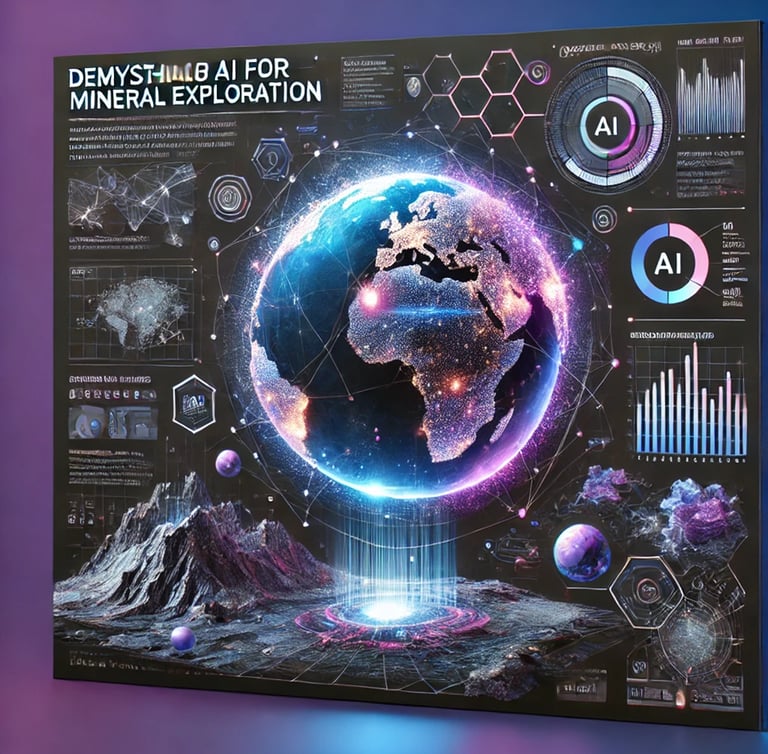Demystifying AI for Mineral Exploration
Xuan-Ce Wang
2/16/20254 min read


Abstract
The mineral resources hidden beneath our feet have long been the foundation of modern infrastructure and industry. Traditionally, mineral exploration relied on exhaustive fieldwork, geophysical surveys, and extensive geological analysis. Today, however, the integration of artificial intelligence (AI) is rapidly transforming the sector. This paper examines how AI is revolutionizing mineral exploration by enhancing data analysis, enabling targeted investigations, reducing costs, and fostering collaborative approaches. It also addresses the key challenges—such as model accuracy, data security, scepticism among stakeholders, and shifts in organizational culture—that must be overcome for widespread adoption. Finally, the paper discusses the transformative potential of deep learning neural networks in providing more nuanced geological insights and predictive capabilities, underscoring AI’s complementary role alongside traditional expertise.
1. Introduction
The world beneath our feet holds a treasure trove of minerals vital to modern life. For centuries, unearthing these resources has depended on labor-intensive fieldwork, geophysical surveys, and geological analysis. Today, however, this landscape is rapidly evolving. AI-driven mineral exploration is emerging as a game-changing innovation—one that promises not only enhanced efficiency and accuracy in identifying mineral deposits but also a more sustainable approach to mining.
Despite its promise, AI is often perceived as complex and enigmatic. This paper demystifies the technology, exploring how AI contributes to modern mineral exploration and identifying the barriers that remain to be overcome for its full adoption.
2. AI-Driven Mineral Exploration: Applications and Benefits
AI’s strength lies in its ability to process vast amounts of data and extract meaningful patterns from it. In mineral exploration, this capability translates into several key benefits:
2.1 Data Analysis and Prediction
Processing Massive Datasets: AI algorithms can rapidly analyze geological surveys, satellite imagery, and historical exploration data. Machine learning models—particularly neural networks—can detect patterns, anomalies, and indicators of mineralization that might elude conventional methods.
2.2 Targeted Exploration
Focused Investigations: By mining geological data for specific indicators, AI enables the pinpointing of areas more likely to contain particular minerals. This targeted approach minimizes both exploration costs and environmental impacts by concentrating efforts where success is most probable.
2.3 Improved Efficiency and Cost Reduction
Streamlined Workflows: AI-powered tools accelerate the analysis process, reducing the time required for exploration and enabling quicker, more informed decision-making regarding viable mining sites. The resulting efficiency not only cuts costs but also shortens project timelines.
2.4 Expanded Collaboration
Synergy of Expertise: When AI is combined with the nuanced insights of geologists and engineers, a powerful synergy is created. Human experts can provide critical context to AI-generated data, refining predictions and ensuring that the interpretation of results is both accurate and actionable.
3. Challenges of Implementing AI in Mineral Exploration
While AI offers considerable advantages, its integration into mineral exploration is not without challenges. Several critical hurdles must be addressed:
3.1 Accuracy and Reliability
Model Validation: Ensuring the accuracy and reliability of AI models is paramount. These algorithms require continual refinement and rigorous validation to improve their predictive capabilities and minimize errors.
3.2 Data Privacy and Security
Safeguarding Sensitive Information: AI systems depend on large datasets, including sensitive geological data. Protecting this information against unauthorized access and breaches is crucial, necessitating robust security measures that balance data accessibility with stringent privacy protocols.
3.3 Scepticism
Industry Adoption: Many stakeholders remain cautious about embracing AI-driven approaches, often due to an entrenched reliance on traditional exploration methods. Overcoming this scepticism involves demonstrating clear, tangible benefits—such as cost savings, improved resource allocation, and the discovery of previously overlooked deposits.
3.4 Culture and Workflow
Organizational Change: Successfully integrating AI into mineral exploration demands a shift in organizational culture and workflows. This transition often requires redefining established practices and structures, which can meet with resistance within traditional frameworks.
4. Harnessing Deep Learning Neural Networks in Mineral Exploration
Deep learning neural networks, a subset of AI, are poised to play a transformative role in the future of mineral exploration. Their unique strengths include:
4.1 Deep Learning Neural Networks and Geological Understanding
Recognizing Complex Patterns: Neural networks excel in discerning intricate patterns within large, heterogeneous datasets. When trained on diverse geological inputs, these models can detect subtle indicators of mineralization that conventional methods might overlook.
4.2 Enhanced Predictive Capabilities
Forecasting Mineral Occurrences: By assimilating and interpreting data from various sources—ranging from geological surveys to geochemical analyses—deep learning models can predict the likelihood of mineral deposits with unprecedented accuracy. This predictive power guides exploration efforts more effectively and reduces uncertainty in decision-making.
4.3 Complementary Powers
Augmenting Human Expertise: AI is not a substitute for traditional geological expertise; it is a complementary tool. The fusion of AI’s computational power with the intuitive understanding of experienced geologists enables a more responsible and sustainable approach to resource exploration. This partnership ensures that the benefits of advanced analytics are fully leveraged while preserving the critical human element of contextual insight.
5. Conclusion
AI is redefining the mineral exploration landscape. By enabling sophisticated data analysis, targeted exploration, cost reduction, and enhanced collaboration, AI-driven methods promise to transform how we discover and develop mineral resources. Yet, challenges remain—particularly in terms of model accuracy, data security, industry scepticism, and the need for cultural shifts within established workflows.
The integration of deep learning neural networks offers a compelling vision for the future: one in which AI’s ability to interpret complex geological data complements and amplifies human expertise. In demystifying AI for mineral exploration, this paper underscores that technology is not an end in itself but a powerful enabler—one that empowers geologists, miners, and environmentalists alike to explore the Earth’s mineral potential responsibly and sustainably for the benefit of future generations.
---
This paper serves as a comprehensive overview of the transformative potential and challenges of AI in the realm of mineral exploration, offering insights into both current applications and future directions.








